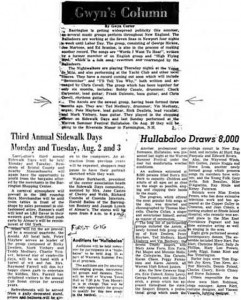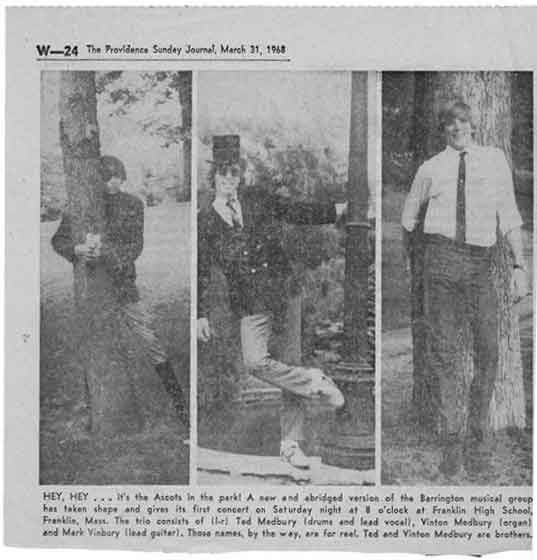The Ascots, The White Wash & Deviled Ham
2015 INDUCTEE
Rock ‘n’ Roll
IN THE MIDNIGHT HOUR
The Story of
THE ASCOTS
by Rick Bellaire
The story of The Ascots from Barrington, Rhode Island, exemplifies the “garage band” experience of mid-1960s America in every way. They were at the apex of what was, arguably, the most exciting time in the history of Rhode Island popular music.
During their five-year career, they rode the second wave of Rock ‘n’ Roll set in motion in 1964 by the British Invasion and evolved from a four-piece cover band into a highly original underground band, sometimes following the trends, sometimes setting them. They saw it all – the highs and lows, the ups and downs – and along the way experienced some of the biggest local hits in Rhode Island music history, performed as an opening act for many of their heroes, and, eventually, scored a major label record deal.

In the beginning: Ascots ’65! Ted Medbury (drums), Mark Vinbury (playing the bass lines on a six-string guitar!), Peter Mayhew (lead guitar) and Rick Desilets (rhythm guitar)
The group, composed entirely of Barrington High School students, originally formed in 1965 as a four-piece, Beatles-styled combo, but added a keyboard player (the drummer’s brother) during its first year of existence. The lineup for the remainder of The Ascots’ run was:
Rick Desilets: Lead vocal, rhythm guitar, occasional lead guitar
Peter Mayhew: Lead guitar
Mark Vinbury: Bass guitar
Ted Medbury: Drums, occasional lead vocal
Vin Medbury: Keyboards
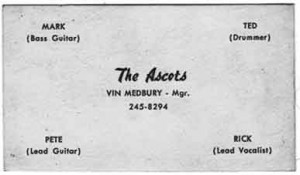
Vinny’s business card showing him as The Ascots’ manager before he joined the band as their keyboardist.
They found almost immediate success on the teen circuit of high school and CYO dances, under-18 dance halls, and Battles-Of-The-Bands, usually held at local amusement parks during the summer months. They rose to the top of this circuit which included some great – now legendary (at least in Rhode Island) – bands such as The Mojo Hands (The Ascots were “The Beatles” to the Mojos “Rolling Stones”), The Accents, The Yeomen, and a year or so later, the youngest of them all, J. P. & The Modified Three. The repertoire for The Ascots and most of the other young bands was drawn from the same pool: The British Invasion sounds of the Beatles, Stones, Animals, Kinks and Hollies; the California sound of The Beach Boys and the surf bands; the folk-rock sounds of The Byrds and The Lovin’ Spoonful; and for the more adventurous of the bands, the R&B sounds gleaned at first from the cover versions learned from album tracks by the above acts, and later directly from the Motown and Stax acts and the blues greats themselves as those sounds began to infiltrate the mainstream.
Although confined to venues for the under-aged crowd at first, the excitement generated by The Ascots and their ever-growing fan base of rabid fans did not go unnoticed in the adult community.
Two employees of Rhode Island’s newspaper of record, The Providence Journal, had become acquainted with the band’s success by the sheer volume of advertising featuring the group which came through the paper’s ad desk. Walt Davis and Buzz O’Neil went to see the band and decided to make an offer to manage them. The band accepted their offer and it was off to the races for The Ascots.
At first, the two managers confined their efforts to promoting and publicizing the group along the same path they were on (getting bookings for teen dances, entering the group in Battles Of The Band, generating press coverage). Along those lines, Davis and O’Neil felt they should get a record released on the group to enhance their promotional efforts and consulted with popular WPRO-AM disc jockey Joe Thomas. He suggested they get in touch with “Big Al” Pavlow, a behind-the-scenes power on the local musical landscape. Not only had Al had been running a successful record shop in downtown Providence for several years, but he’d already produced and released a record by local singer Cal Raye on his own Super Records label. Al had connections with many of the major labels through his contacts in the store with the New York promo men and salesmen and he had already established a reputation as a “guy with ears”: he regularly consulted on which new releases to add to the playlists at all of the area’s leading Top 40 stations.
At the managers’ invitation, Al went to see the group in the summer of 1966 at a WICE-sponsored Battle Of The Bands. His reaction was swift: he liked what he heard and saw and agreed to become the band’s producer. He began attending the group’s rehearsals with an ear toward choosing material for their first recording session. Although the group was still playing mostly cover versions of popular songs and were just beginning to dabble in song writing, they had by this time developed a very unique “sound” with a very original approach to their arrangements. Late in the summer, Al took the band down to New York City to the legendary Bell Sound recording studios for their first recording session.
Two sides from that session were chosen for the band’s first release: on the A-side, it was Sam The Sham & The Pharoahs’ “Monkey See- Monkey Do” (a relatively obscure song which could only be found on the soundtrack to the Connie Francis teen-exploitation movie When The Boys Meet The Girls), and for the flip, an energetic take on “You Can’t Do That”, a Beatles album track. Super Records #102 was released in the Fall of ’66 to an initially enthusiastic reception from both radio and the band’s fans. Both of the area’s top stations, WICE and WPRO, had decided to go with the flip side – the Beatles cover – and the record did not do as well as hoped, but still reached #37 on the WICE chart. WICE even attempted a second run by flipping the record over to the originally intended A-side, but #102 had run its course.
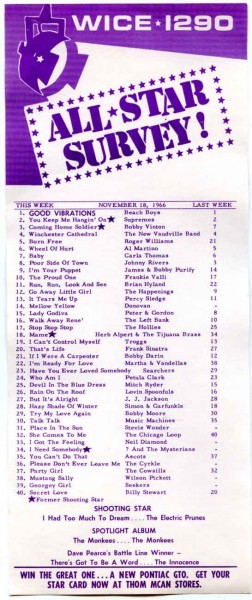
Pavlow was encouraged by the record’s performance in the marketplace and decided to go ahead with a second release. The band had developed a show-stopping, five minute version of Wilson Pickett’s soul classic, “In The Midnight Hour”, and had cut it at their first recording session. Realizing that no station at that time would program a record over 3 minutes long, Pavlow edited the take into a two-sided version and Super Records #103 became “Midnight Hour” (Part 1) b/w “Midnight Hour” (Part 2).
The record exploded onto the scene. They got immediate adds at not only WICE and ‘PRO, but on just about every other Top 40 station in southern New England. After moving east into the Fall River, Massachusetts market, the record made it’s way north as far as Maine and as far west as the Berkshires.

The Ascots providing the soundtrack to the Summer Of Love at the beaches in the South County area of Rhode Island, 1967
“Midnight Hour” had a three and a-half month chart run and sold thousands of copies, hitting the Top 10 on every major station in the area. It is “the” version of “Midnight Hour” for anyone over fifty in New England. The only thing which kept the record from going national were the competing regional versions flooding the major markets around the country. The song had been only a minor Top 40 success for Wilson Picket, but it was the “blue-eyed soul” version included by The Young Rascals on their debut album which helped thwart Ascots record. The song had become extremely popular amongst the garage bands and every area of the country had its “own” version of “Midnight Hour”. The version which probably stopped Super #103 from continuing its journey westward was the one by Michael & The Messengers on USA Records out of Ohio which had taken the midwest by storm.
Ironically, their front man, vocalist/keyboardist Michael Morgan, will play an important role a bit later in this story.
As their records took off and the group members left high school, Davis and O’Neil were able to move the group onto the college and club scenes flourishing throughout the state. It was a scene dominated by a roster of just-slightly-older, very successful bands which included The Others (University of Rhode Island students who had managed to secure an RCA Records deal), The Blue Jays (Dick Domane’s R&B-oriented group), Paul Franklin’s P.F. & The Flyers, Georgie Porgie & The Cry Babies (already recording for Jubilee), the mighty Northeast Expressway, Ken Lyon’s Tombstone Blues Band featuring a young Duke Robillard, and The American Dream (a couple of years away from morphing into Benefit Street). The Ascots quickly took their place amongst this upper echelon of Rhode Island bands. They moved into opening act slots at major venues, including the Rhode Island Auditorium in Providence and college gymnasium productions at most of the local schools, and performed with an “A” list of acts including The Who, The Beach Boys, The Rascals and Herman’s Hermits. It seemed as if The Ascots could do no wrong and that real success was just around the corner.
But their next release, a cover of Don Covay’s “Sookie Sookie”, fell flat. For their next record, Al and the group decided on a slight change of direction. The band had performed the previous year in Newport, Rhode Island, with a popular Long Island band, The Pigeons (who were on the verge of a name change to The Vanilla Fudge), and were privy to the original, slowed-down, psychedelic arrangement of The Supremes’ “You Keep Me Hanging On” which put the Fudge on the map. Taking their cue from that approach, Al and the boys cut a Fudge-styled, but nonetheless, very original-sounding version of The Kinks song, “I Need You”, with drummer Ted Medbury on lead vocal. The record found a home on the radio and sold out of its initial pressing just as it peaked at #10 on WICE. It was determined that a second pressing would probably just sit on the shelves as the record worked its way down and Super Records 105 became the last release by the original group.
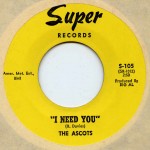

Rising to the top! By 1967, the young high school band had achieved headliner status and were being billed above some of the area’s top draws including the college-based group The Others who’d had three national major label releases. (Poster courtesy Eileen & Peter Mayhew)
THE WHITE WASH ERA
Although the club and college scenes were still an ongoing, lucrative proposition, by 1968, it appeared The Ascots’ sound had run its course. The band took some time off to regroup and decide on a new direction for their music and, during this re-think, the band’s front man, Rick Desilets, left the group. Shortly thereafter, their lead guitarist, Peter Mayhew, opted out as well. The remaining members decided to continue on as a three-piece (although they briefly added a second drummer during initial rehearsals) with the Medbury brothers handling the vocals. Vin Medbury, who had already graduated from Farfisa and Vox combo organs to a Hammond B-3 organ with Leslie speaker, had evolved into a great showman and was to become the new focus of the band. He had also become adept at playing bass lines on the foot pedals of the B-3 and Mark Vinbury made the switch to guitar at this point. (This was an unusual move for the era and a testament to Vin’s abilities – only two other bands of note during that time were performing without a bass player: The Rascals, with Felix Cavaliere supplying the bottom on his B-3’s pedals, and The Doors, with Ray Manzarek playing left-hand bass lines on a Fender Piano Bass keyboard. It should be noted that within months, both of those bands began to hire bass players to accompany them on the road; Mark, Ted and Vin remained a three-piece until the end.) Around this time, the band’s managers, Davis and O’Neil, dropped out of the picture and the group continued on without management with Big Al and Vinton fielding booking inquiries.
The group supported themselves for a while by playing-out The Ascots already-booked engagements and began to woodshed. They were assisted in this effort by jazz guitarist/music store owner Carl DeStefano who had a shop in the Mount Pleasant neighborhood in the north end of Providence (first on Academy Avenue and, later, around the corner in a strip mall off Chalkstone Avenue). He had helped them procure some of the new, powerful, heavy-duty equipment they’d need to present a trio and found them rehearsal space in the hayloft of a converted barn just around the corner from the store.
(I’d like to mention that the band attracted a great “sidewalk” following during this time, especially with the younger musicians in the neighborhood. Amongst the Chalkstone Ave. habitues besides myself during this period were keyboardist Lucien Spino, legendary Rhode Island drummer, the late Billy Carson, and the members of the aforementioned J.P. & The Modified Three. We knew the guys up in the loft “used to be The Ascots”, and we’d hang out, listening to the great, strange music coming from up above.)
That winter, the band moved to a new rehearsal space at Pollard Farm on the Wampanog Trail in the East Bay on the Barrington/East Providence line. (The farm was owned by the family of Ted’s girlfriend and future wife.) According to Mark Vinbury, it “…was a great place to play as far as making all the noise we wanted, but cold in the Winter.” As the music took shape, there was one last piece of business: a name change. The group decided on “The White Wash”.
Reconnecting with Al Pavlow, the group returned to Bell Sound in New York City to cut a single which was released on Al’s new Super Records subsidiary, Zowie Records. (No one seems to remember why the label name-change – perhaps it was to differentiate between the new lineup and the Ascots releases or perhaps it was more in keeping with the times…maybe “Super Records” just sounded too “old-fashioned”?)
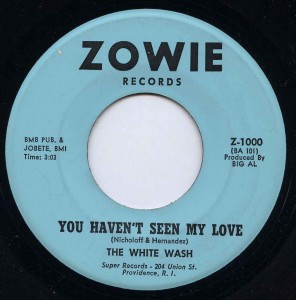
The record (Zowie Z-1000) is as fine a piece of late-garage band/psychedelia as one could hope to find. The A-side was a cover of the obscure, now classic, garage band anthem “You Haven’t Seen My Love”, originally written and performed by The Ones out of Lansing Michigan. The B-side marks the first original composition released by a member of The Ascots, bearing the writing credit for the group’s new front man, “Vinton W. Medbury, Jr.” The record propelled the group onto the blossoming “underground” scene in Rhode Island and they found themselves not only performing at various festivals and other “hippie” venues (such as Hung Up, a clothing store on the East Side of Providence servicing the Brown University/Rhode Island School of Design community which presented music on the weekends), but opening for Janis Joplin and Sly & The Family Stone.
DEVILED HAM & BUDDAH RECORDS
Pavlow and the group continued refining the sound as the band developed its act onstage. They began incorporating all of the latest developments for a rock band’s presentation – light show, costumes, longer pieces of music – as the group worked the college and club scenes.
The were also incorporating original material into the act and were developing a long-form piece called “The Raven”. It was a twenty-minute, psychedelic tour-de-force based on a medley of The Electric Prunes’ “I Had Too Much To Dream Last Night” and the theme song from the recently released motion picture Rosemary’s Baby, over which they sang/recited Edgar Allan Poe’s epic poem, “The Raven”. Vin Medbury had, by this time, become a mesmerizing front man, dressed in (for the time) outrageous stage gear and acting out the narrative of the poem as the band performed the music. “The Raven” got a lot of notice in the area and a great response from the audiences and it was determined that it should become the centerpiece for the band’s next venture: an entire album.
(It should be noted here that, in 1968, “Big Al” Pavlow and The White Wash were way ahead of the curve as far as “Theatrical-“, “Glam-” or “Shock-” Rock is concerned: the Alice Cooper band was still in Arizona performing Yardbirds covers as The Nazz, unaware of Todd Rundgren’s act from Philadelphia who were about to break nationally, and David Bowie was a failed, pop singer hedging his bets by studying/performing with a mime troupe.)
Pavlow and the band returned to New York City for what would become their last recording session at Bell Sound. This time, however, the approach would be quite different. They would not only record an entire album for which they controlled the master, but they would prepare an entire “package” of promotional materials to interest the major labels: they adopted a new name – more in-keeping with their new image – Deviled Ham; Pavlow commissioned Cambridge, Massachusetts film maker Ken Brown (then just beginning an illustrious career as a film maker, animator, and music video pioneer), to shoot a full-length, 20 minute promotional video for “The Raven”; and they concocted a mock-up for the album’s cover art which referenced everything about the group and its new direction. The album perfectly captures the sound of the band at that moment. Side A has six songs (including two more Vin Medbury originals) which build tension while leading up to “The Raven” which occupies the entire B-side.
Pavlow showcased the group in New York City and began making the rounds of the majors. He was successful at Buddah Records, then run by Neil Bogart. Buddah was known as the home of “bubblegum” music and Bogart was looking to move the label into the underground rock scene. He’d already signed Elephant’s Memory (later the backing band for John Lennon and Yoko Ono) and the Eire Apparent (a Northern Ireland psych band produced by Jimi Hendrix). At just 25 years old, Bogart had something of a “whiz kid” reputation in the business and it seemed like a good fit. Deviled Ham were poised for a national breakthrough.
But as so often happens in the music business, fate intervened in the form of Curtom Records. Singer-songwriter-producer Curtis Mayfield of The Impressions had formed his own production company in the mid-’60s and after seeing initial success for his efforts, was looking for a new home for his imprint. Buddah signed Curtom in 1968 and began aggressively targeting the R&B market, a market previously untapped by the label. Somewhere during this time, Bogart informed Pavlow that the album was “on hold” and its release not in their immediate plans. As the months wore on and the calendar turned over into 1969, the members of Deviled Ham found themselves losing heart. The club dates and festival gigs were still there, but their long-term prospects looked dim. At some point in 1969, Vin decided to leave the band. Mark and Ted carried on, forming a new band, Thunderchicken, to play the New England club circuit under the aegis of powerful Rhode Island booking agent Ricky Carr. The lineup was rounded out by Frank “Snuffy” Curtis and his wife, Leslie, who fronted the band, and bass player Bob Munz, formerly of Boston band The Orphans. “Big Al” rededicated himself to his retail operation and Deviled Ham marked his last foray into the music side of the record business.
EPILOGUE

There is one final chapter in the Ascots saga. Although, perhaps not the “happy ending” we would like to have seen, it is nonetheless an interesting side note in Rhode Island music history. Sometime during 1970, Al Pavlow received a call from Buddah Records asking for label copy for the album – it was back on their release schedule.
The album was finally released in 1970 as “I Had Too Much To Dream Last Night” on Buddah’s SuperK subsidiary (SKS-6003). The original cover art was dropped in favor of a generic, psychedelic illustration by painter David Wilcox with no mention of the band’s personnel; there was minimal advertising and little or no promotion (no single was sent to radio); and the music was over two years past its “sell-by” date. The album beat a quick retreat into the cutout bins. Over the last 40 years, however, the album has been rescued from obscurity by the rabid collectors in the psychedelic market and has become a prized collectible. Across the internet, there are several websites and blogs featuring pages discussing the merits (and demerits) of the work. The album is a gem and definitely worth seeking out on eBay or other collectors’ websites. As an ahead-of-its-time, intriguing slice of psychedelia, it is a grand feather in the cap of Rhode Island Rock ‘n’ Roll music history.
TED MEDBURY
Drummer/vocalist Ted Medbury relocated to Los Angeles, California where he formed a wonderful folk-rock unit called The Movies with two other veterans of the Rock ‘n’ Roll wars: folk singer and songwriter Peter Barnes and keyboardist/vocalist Michael Morgan – ironically, the same “Michael” of Michael & The Messengers whose version of “Midnight Hour” had kept The Ascots recording from moving into the midwest. Their album for Arista Records is a light-hearted affair, reminiscent of The Lovin’ Spoonful and latter day Byrds, and had a good promotional push from the label. There was a good deal of advertising and the group appeared on national television several times including Saturday Night Live With Howard Cosell and The Merv Griffin show (and possibly, The Tonight Show Starring Johnny Carson). The single, “Satellite Touchdown”, however, failed to click at radio and the album wound up in the cutout bins.
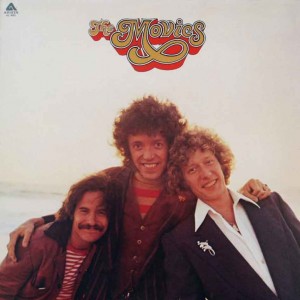
There is a second important Rhode Island connection concerning The Movies. The album and single were produced by Vini Poncia, formerly half of the songwriting/production team of Anders & Poncia. Peter Anders and Vini Poncia were Rhode Island natives who saw great success in the 1960s as writers, producers and/or performers with The Videls, The Tradewinds, The Ronettes and The Critters. After their split in 1972, Poncia had become a major player behind the scenes in the music business and was riding high with production and song credits for Ringo Starr and Melissa Manchester and, in 1976, was just about to win a Grammy as the composer of Leo Sayer’s “You Make Me Feel Like Dancing”. Although, the pair had split professionally, they were still fast friends and Vini brought Peter’s song, “If I Can Just Get Through Tonight” to the band. Theirs is the first recording of this now classic song.
(Russell Javors, guitarist for the Billy Joel Band for more than two decades, recently told me that he used to go to see The Movies in New York City when they were promoting the album and thought they were terrific live. The highlight of their show, for him, was the Peter Anders song and inspired by their arrangement, pitched the song to Phoebe Snow over the years which led, a decade later, to her hit recording for Elektra.)
The following year, the non-album, B-side of the single, “Ahead Of The Game”, was chosen as the theme song to the original motion picture version of Fun With Dick & Jane (which starred George Segal and Jane Fonda). The song was reissued as a promotional single, but this record also failed to find a home on the radio. There was one more single recorded for Arista in 1977 with a new producer, Richard Podolor. Again, the single did not reach the airwaves and the band was dropped. The Movies disbanded shortly thereafter. Ted Medbury is still in southern California and still active in music. 2015 saw the release of an album by his latest project, the Los Angeles-based Shelly O’Neill & The Big Way.
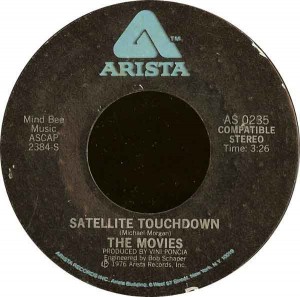
VINTON MEDBURY
Although it might look at first glance as if Ted was the most successful of the ex-Ascots, in terms of career longevity, that prize would go to his brother, Vinton. He relocated to the San Francisco Bay area of northern California and quickly built a reputation and following on the club scene. He performed under the stage name “Uncle Vinty” and he pioneered the concept of “performance art” on the West Coast at a time when the movement was just beginning to gain some strength in New York City with Lennon & Ono, the post- “Happenings” Warhol crowd, and the young Laurie Anderson. His territory and following extended into western Canada and over the course of 25 years, he released several independent recordings and films and, at one point, even had his own television show. In another ironic twist of fate, two of the musicians in his backing band during the 1980s were two former members of none other than Michael & The Messengers! Vin passed away in 1994, but his friends, fans and collaborators have posted an entire website and blog devoted to him where his life and work are discussed in detail with great fondness and reverence.

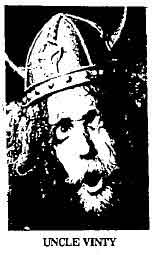
MARK VINBURY
Mark remained in Rhode Island and made his mark as an accomplished lead guitarist. He has also become a steel guitarist of note.
PETER MAYHEW
Peter also stayed in the state and continues to be involved in music, occasionally performing with Mark and members of other local bands from the great “garage band” era.
RICK DESILETS
The Ascots lead singer and frontman has also remained in Rhode Island. In the early 1970s, he released an independent single, “Look At Me.” It’s an original song and a fine effort. It is an almost “classical” sounding pop gem, somewhere between The Left Banke’s “Pretty Ballerina” and the early part of Cat Stevens’ second career on A&M (“Mona Bone Jakon” and “Tea For The Tillerman”). In 1998, he released an album on CD under the group name “Blue Angel” in partnership with another musician, Harry Dorsey.

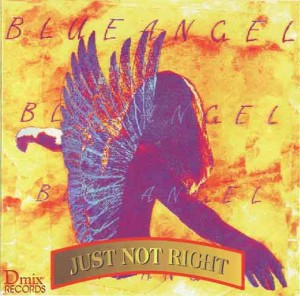
On April 26, 2015, The Ascots were inducted into the Rhode Island Music Hall of Fame. Rick, Ted, Peter and Mark were all on hand to accept their awards and the band performed for the first time in forty-five years with Rick’s brother, Bob Desilets, deputizing for the late Vinton Medbury.

Rhode Island Music Hall of Fame Induction Ceremony & Concert (left to right): Rick Desilets, Ted Medbury, Peter Mayhew and Mark Vinbury
The author would like to thank the Ascots/White Wash producer, “Big Al” Pavlow, Movies producer Vini Poncia and, especially, Mark Vinbury who provided some of the charts and most of the ads, newspaper clippings and photographs
DISCOGRAPHY
THE ASCOTS
Super S-102: Monkey See – Monkey Do b/w You Can’t Do That (1966)
Super S-103: Midnight Hour (Part 1) b/w Midnight Hour (Part 2) (1967)
Super S-104: Sookie-Sookie b/w Put Your Arms Around Me (1967)
Super S-105: I Need You b/w Knock On Wood (1967)
THE WHITE WATER
Zowie Z-1000: You Haven’t Seen My Love b/w You Better Think It Over (1968)
DEVILED HAM
SuperK/Buddah LP SKS-6003: I Had Too Much To Dream Last Night (1970)
THE MOVIES
Arista LP AL-4085: The Movies (1976)
Arista AS-0235: Satellite Touchdown b/w Ahead Of The Game (1977)
Arista AS-????: Ahead Of The Game b/w Ahead Of The Game (1977)
Arista AS-0261: Hello, Hello Young Lovers b/w Mystery Creek (1977)
UNCLE VINTY
Criminial Records EP-101: Uncle Vinty Wants You (1980)
RICK DESILETS
D&D D-1000: Look At Me (Vocal) b/w Look At Me (Instrumental) (19??)
BLUE ANGEL
Dmix CD Album (no # shown): Just Not Right (1998)
LINKS AND REFERENCES
For more information about the Rhode Island garage band scene of the 1960s, we recommend the following book, available at Amazon.com and other internet booksellers. It was written by a Warren, Rhode Island resident who spent his formative years ensconced in the local scene. Although the book focuses primarily on one of Rhode Island’s greatest bands, The Mojo Hands (mentioned earlier in this entry), there is a quite a bit of information about The Ascots and the scene in general during its heyday:
We Gotta Go Now, Dennis A. Blackledge, 1998, Windholme Press
For a wealth of information on the life and career of Vinton W. “Uncle Vinty” Medbury, Jr., please visit:
www.unclevinty.com
To learn more about the career of The Movies producer, Vini Poncia, and song writer, Peter Anders, both Rhode Island natives, please visit:
www.andersandponcia.com
Another web page worth visiting for more info on the Rhode Island scene (which focuses on URI’s The Others) is found here:
www.60sgaragebands.com/others.html.

